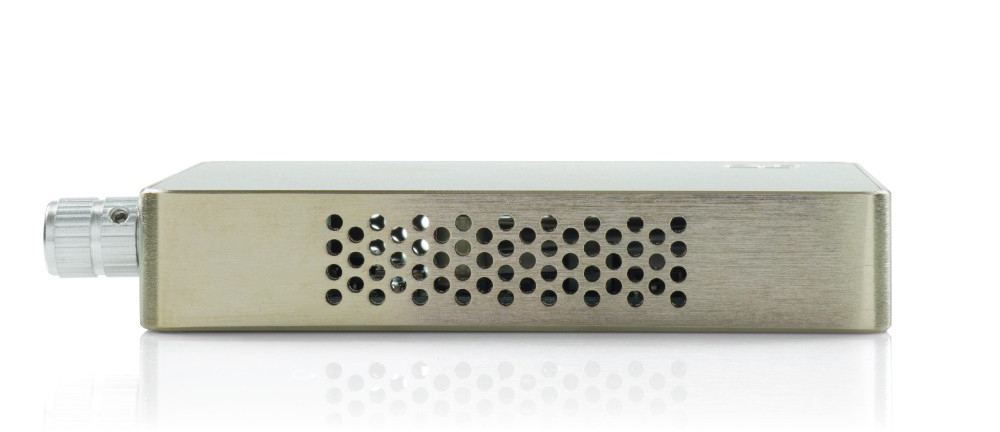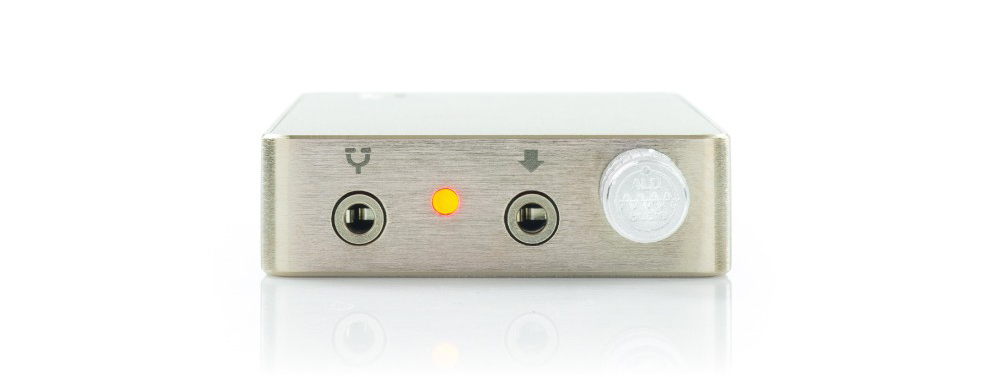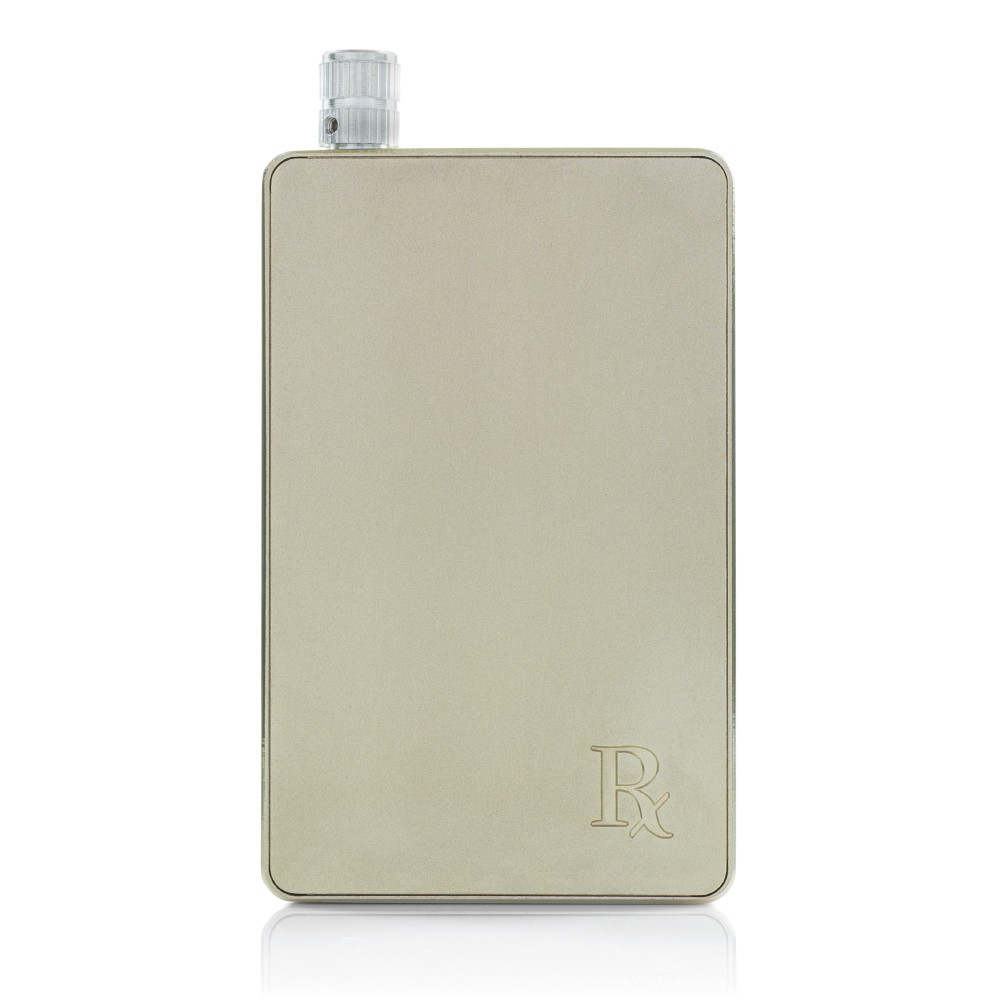In 2009 we were introduced to a company that went by the name ALO (Audio Line Out) Audio and they brought with them a new portable amplifier, the ALO Rx. Since then they’ve released several improved iterations of the Rx and eventually showed us the now well-known ALO Rx Mk3 – B+. But more recently ALO noticed an area of the market that could use a little of their magic and as a result they’ve unleashed the new ALO Rx upon the world.
The new ALO Rx is a portable amplifier designed for the modern realm of IEMs. Many portable amps on the market today try to be a jack-of-all-trades device capable of driving everything from moderately efficient headphones all the way up to the more power-hungry full-sized cans. Unfortunately these devices often end up with a high noise floor as a result and we hear a low hiss on sensitive IEMs. Thankfully the new ALO Rx is here with their low-noise IEM solution.
At first glance the new Rx possesses a rather elegant yet simple aesthetic in its design. It has a limited edition nickel-plated enclosure CNC’d from aluminum. There is a small Rx logo engraved on the front of the housing and a series of openings on either side for ventilation. On the bottom we have a micro USB port to recharge the internal battery and an LED charging indicator. Finally on the top of the enclosure we have a conductive element type plastic potentiometer, a 3.5mm stereo input, a single LED, and a 3.5mm stereo headphone jack.
Thankfully the same level of detail that went into the enclosure remains intact inside as well. One of the key features of the new ALO Rx is its exceptionally low output impedance coming in just under 0.5 Ohm. This is great because it allows the new ALO Rx to drive any modern IEM on the market with ease. It also delivers a generous amount of headroom thanks to its 15 volt amplifier. Paired with the high quality ESR Aluminum Organic Polymer capacitors the ALO Rx provides crystal clear and distortion free detail throughout its quoted 10 Hz to 50 kHz frequency response.
Using the ALO Rx in my daily travels has been a very pleasant experience. One of the aspects I immediately loved about the ALO Rx was that its volume pot gave me a very comfortable amount of play when compared to other portable amps that I’ve used. For example I have the relatively common E12 from FiiO, a great portable amplifier in its own right, but one that doesn’t provide enough adjustment room on the volume pot before it gets too loud with my sensitive CIEMs. That makes it difficult to fine-tune the volume level when I’m not wearing my more demanding headphones.
Having said that I want to make one thing absolutely clear to the readers; the ALO Rx is not intended for even moderately inefficient headphones. While it does a fantastic job driving my 1964-Q CIEMs it cannot push my Koss PortaPro beyond a moderate volume, a headphone that can easily be driven by a small Sansa Clip+ player. If you’re not an IEM user the ALO Rx will most likely not be the portable amp for you. But if you’re like me and you find IEMs indispensible then let’s move on.
I found the size of the ALO Rx to be right in line with many portable sources readily available. It rested comfortably alongside an Astell&Kern AK120 coming in just slightly taller but with a similar width and depth. The ALO Rx measures 0.69” and just squeezes under the line that many consider too thick. A depth of 0.7” is what many, myself included, consider the cutoff for a device that’s meant to be stacked with a source. Previous generations of the Rx have been thinner, some coming in as low as 2.5” deep, but they were also wider as a result. Considering what’s gone into the ALO Rx I’m not sure Ken could have made it any narrower than it currently is without making it wider as a result.
However, we must not ever overlook the main reason we’re here, the sound. In my time with the ALO Rx I’ve come to learn that it does a fantastic job of keeping the same quality of sound it’s given. My Sansa Clip+ has a warm sound signature and the ALO Rx maintained that warm signature throughout. And when paired with the Sansa I noticed that the ALO’s higher quality power rails were able to give me better separation and a cleaner presence throughout. It still had that familiar warm signature that I’ve come to expect from the small DAP but delivered at a level of quality that the little Clip+ could never dream to deliver on by itself. The older Rx models had a bit of color to the sound and it’s wonderful to see that the new ALO Rx breaks that trend in favor of a flatter design that can really show off the implementation of any DAC feeding it.
The same scenario can be applied to DAPs that have a more neutral signature or ones that provide a very sharp and detailed sound. The ALO Rx will do a fantastic job of maintaining the sound quality of any source without adding any coloration of its own. If you’re an IEM user and you have a source that can provide your favorite sound signature then this should be an amp you consider purchasing.

But the icing on the cake for the ALO Rx’s sound has to be that midnight black background. Even with the volume maxed I couldn’t find even a hint of noise from the amp. While there are several IEM-centric amplifiers on the market but it’s difficult to find one as silent as the ALO Rx. This gives the music excellent instrument separation and imaging. When fed a high-resolution track I was also able to hear room acoustics much more clearly than with any of the other portables in my collection. In short the low noise level of the ALO Rx is wonderful.
Unfortunately there is one shortcoming of the ALO Rx that stands out to me. One of the considerations that should be made when choosing this kind of portable amp is electromagnetic interference (EMI). If you plan to use the ALO Rx with a DAP that has no cellular antenna then you shouldn’t notice any issues. If you plan to use the ALO Rx with a cellular device then know that the ALO Rx will pick up some EMI. EMI most often manifests itself in the form of static or clicking and happens frequently with cell phones because they’re communicating with cell towers roughly every 15-30 seconds. The ALO Rx isn’t very well shielded against EMI but in all fairness it is less noticeable than some other portable amps for purchase today.
Other than its potential issue with EMI I’ve had a hard time finding any issue with the ALO Rx. The volume pot is always smooth and responsive. Unfortunately plastic always has a stigma of cheapness associated with it. It’s not always wrong but I’m happy to report that in the case of the ALO Rx’s pot, it is. It feels absolutely wonderful and solid during use. On top of that I absolutely adore the fine level of control I get with my CIEMs thanks to the IEM focused power output. That’s something none of my other portable amps have been able to achieve.
Heat is also a non-issue with the ALO Rx. Since it has an aluminum enclosure coupled with ventilation on two sides it does a fantastic job with heat dissipation. I left the amp powered on throughout a normal workday and it hardly felt warm let alone hot. That’s what I like to see in a portable device that will be constantly handled. I’m very impressed with this little amp.
I also find it difficult to complain about the $349 price tag. Included with the ALO Rx is ALO Audio’s Green Line micro USB cable; that’s a $149 value on its own. I even love the look of the nickel plating and for those who don’t there’s also a black version in the works. Ken Ball of ALO Audio said that there would be special $299 price when the black anodized version is made available. At that price the ALO Rx is an absolute no-brainer for all of my fellow IEM users.

ALO Audio’s previous generations of the Rx have always stood out for great value and I’m happy to see that the torch burns just as brightly with the new IEM-focused ALO Rx. And unfortunately for my wallet ALO isn’t done releasing new products this year. Let’s see if they can score another run with their next launch the same way they have with the ALO Rx IEM.
The new ALO Rx is a portable amplifier designed for the modern realm of IEMs. Many portable amps on the market today try to be a jack-of-all-trades device capable of driving everything from moderately efficient headphones all the way up to the more power-hungry full-sized cans. Unfortunately these devices often end up with a high noise floor as a result and we hear a low hiss on sensitive IEMs. Thankfully the new ALO Rx is here with their low-noise IEM solution.
At first glance the new Rx possesses a rather elegant yet simple aesthetic in its design. It has a limited edition nickel-plated enclosure CNC’d from aluminum. There is a small Rx logo engraved on the front of the housing and a series of openings on either side for ventilation. On the bottom we have a micro USB port to recharge the internal battery and an LED charging indicator. Finally on the top of the enclosure we have a conductive element type plastic potentiometer, a 3.5mm stereo input, a single LED, and a 3.5mm stereo headphone jack.
Thankfully the same level of detail that went into the enclosure remains intact inside as well. One of the key features of the new ALO Rx is its exceptionally low output impedance coming in just under 0.5 Ohm. This is great because it allows the new ALO Rx to drive any modern IEM on the market with ease. It also delivers a generous amount of headroom thanks to its 15 volt amplifier. Paired with the high quality ESR Aluminum Organic Polymer capacitors the ALO Rx provides crystal clear and distortion free detail throughout its quoted 10 Hz to 50 kHz frequency response.
Using the ALO Rx in my daily travels has been a very pleasant experience. One of the aspects I immediately loved about the ALO Rx was that its volume pot gave me a very comfortable amount of play when compared to other portable amps that I’ve used. For example I have the relatively common E12 from FiiO, a great portable amplifier in its own right, but one that doesn’t provide enough adjustment room on the volume pot before it gets too loud with my sensitive CIEMs. That makes it difficult to fine-tune the volume level when I’m not wearing my more demanding headphones.
Having said that I want to make one thing absolutely clear to the readers; the ALO Rx is not intended for even moderately inefficient headphones. While it does a fantastic job driving my 1964-Q CIEMs it cannot push my Koss PortaPro beyond a moderate volume, a headphone that can easily be driven by a small Sansa Clip+ player. If you’re not an IEM user the ALO Rx will most likely not be the portable amp for you. But if you’re like me and you find IEMs indispensible then let’s move on.
I found the size of the ALO Rx to be right in line with many portable sources readily available. It rested comfortably alongside an Astell&Kern AK120 coming in just slightly taller but with a similar width and depth. The ALO Rx measures 0.69” and just squeezes under the line that many consider too thick. A depth of 0.7” is what many, myself included, consider the cutoff for a device that’s meant to be stacked with a source. Previous generations of the Rx have been thinner, some coming in as low as 2.5” deep, but they were also wider as a result. Considering what’s gone into the ALO Rx I’m not sure Ken could have made it any narrower than it currently is without making it wider as a result.
However, we must not ever overlook the main reason we’re here, the sound. In my time with the ALO Rx I’ve come to learn that it does a fantastic job of keeping the same quality of sound it’s given. My Sansa Clip+ has a warm sound signature and the ALO Rx maintained that warm signature throughout. And when paired with the Sansa I noticed that the ALO’s higher quality power rails were able to give me better separation and a cleaner presence throughout. It still had that familiar warm signature that I’ve come to expect from the small DAP but delivered at a level of quality that the little Clip+ could never dream to deliver on by itself. The older Rx models had a bit of color to the sound and it’s wonderful to see that the new ALO Rx breaks that trend in favor of a flatter design that can really show off the implementation of any DAC feeding it.
The same scenario can be applied to DAPs that have a more neutral signature or ones that provide a very sharp and detailed sound. The ALO Rx will do a fantastic job of maintaining the sound quality of any source without adding any coloration of its own. If you’re an IEM user and you have a source that can provide your favorite sound signature then this should be an amp you consider purchasing.

But the icing on the cake for the ALO Rx’s sound has to be that midnight black background. Even with the volume maxed I couldn’t find even a hint of noise from the amp. While there are several IEM-centric amplifiers on the market but it’s difficult to find one as silent as the ALO Rx. This gives the music excellent instrument separation and imaging. When fed a high-resolution track I was also able to hear room acoustics much more clearly than with any of the other portables in my collection. In short the low noise level of the ALO Rx is wonderful.
Unfortunately there is one shortcoming of the ALO Rx that stands out to me. One of the considerations that should be made when choosing this kind of portable amp is electromagnetic interference (EMI). If you plan to use the ALO Rx with a DAP that has no cellular antenna then you shouldn’t notice any issues. If you plan to use the ALO Rx with a cellular device then know that the ALO Rx will pick up some EMI. EMI most often manifests itself in the form of static or clicking and happens frequently with cell phones because they’re communicating with cell towers roughly every 15-30 seconds. The ALO Rx isn’t very well shielded against EMI but in all fairness it is less noticeable than some other portable amps for purchase today.
Other than its potential issue with EMI I’ve had a hard time finding any issue with the ALO Rx. The volume pot is always smooth and responsive. Unfortunately plastic always has a stigma of cheapness associated with it. It’s not always wrong but I’m happy to report that in the case of the ALO Rx’s pot, it is. It feels absolutely wonderful and solid during use. On top of that I absolutely adore the fine level of control I get with my CIEMs thanks to the IEM focused power output. That’s something none of my other portable amps have been able to achieve.
Heat is also a non-issue with the ALO Rx. Since it has an aluminum enclosure coupled with ventilation on two sides it does a fantastic job with heat dissipation. I left the amp powered on throughout a normal workday and it hardly felt warm let alone hot. That’s what I like to see in a portable device that will be constantly handled. I’m very impressed with this little amp.
I also find it difficult to complain about the $349 price tag. Included with the ALO Rx is ALO Audio’s Green Line micro USB cable; that’s a $149 value on its own. I even love the look of the nickel plating and for those who don’t there’s also a black version in the works. Ken Ball of ALO Audio said that there would be special $299 price when the black anodized version is made available. At that price the ALO Rx is an absolute no-brainer for all of my fellow IEM users.

ALO Audio’s previous generations of the Rx have always stood out for great value and I’m happy to see that the torch burns just as brightly with the new IEM-focused ALO Rx. And unfortunately for my wallet ALO isn’t done releasing new products this year. Let’s see if they can score another run with their next launch the same way they have with the ALO Rx IEM.















Want to join discussion?
Feel free to contribute!